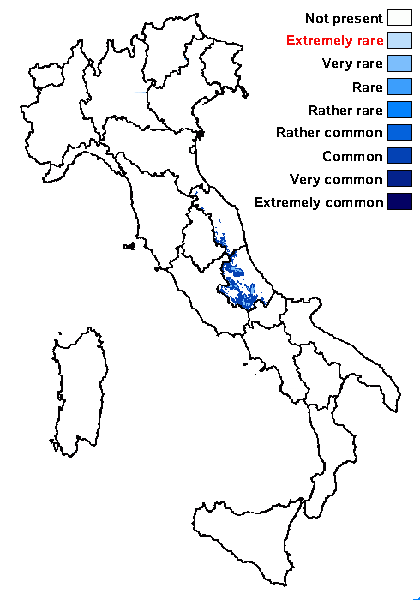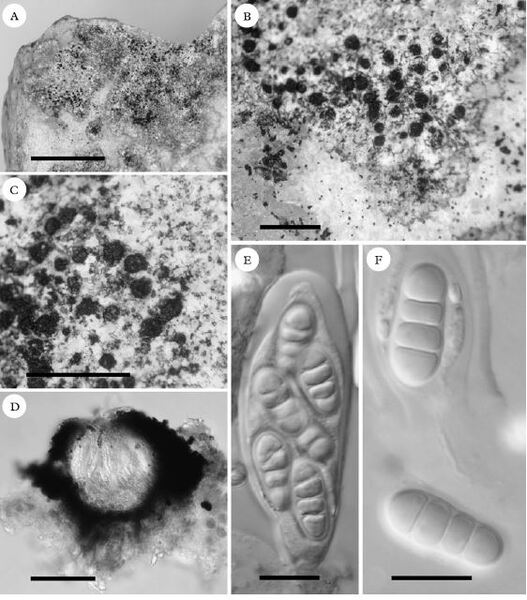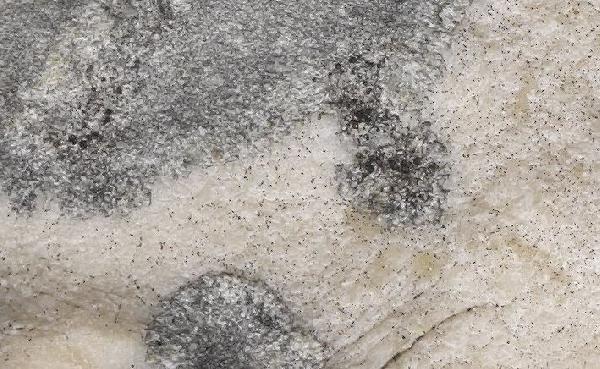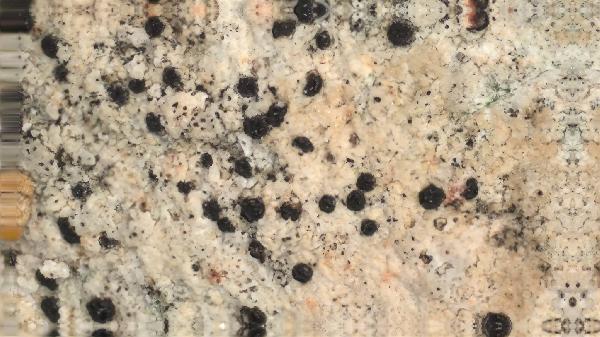Opegrapha vulpina Vondrák, Kocourk. & Tretiach
in Vondrák & Kocourková, Lichenologist, 40: 177, 2008.
Synonyms:
Distribution: C - Marc (Vondrák & Kocourková 2008, Brackel 2016), Abr (Vondrák & Kocourková 2008, Brackel 2016).
Description: Thallus inapparent, not lichenized, the hyphae developing inside the thalli of Pyrenodesmia-species, especially P. erodens. Apothecia round, black, usually gathered into irregular dark patches on the host thallus, sessile, (0.11-)0.2-0.3 mm across, with a finally slightly expanded, epruinose disc and a thin, slightly raised proper margin. Proper exciple black, carbonized, (20-)48-70 µm thick, broader in upper part, formed of paraplectenchymatous thick-walled cells in outer part, of elongated cells in the part adjacent to the hymenium; epithecium covered with brown granules which are insoluble in K and N, I+ blue; hymenium colourless, (70-)90-110 µm high, I+ reddish, K/I+ blue; paraphysoids strongly branched and anastomosing, 2-2.5 µm thick at mid-level, the apical cells, brown-pigmented, up to 5.5 µm wide; subhymenium pale brown to colourless, 30-40 µm high, prosoplectenchymatous, sometimes inspersed with oil droplets, I+ reddish; hypothecium brown-black, 20-30 µm high. Asci 8-spored, narrowly clavate, with a tholus and internal apical beak, Opegrapha-type, (39-)46-56(-67) x (13-)14-18(-21) µm. Ascospores 3-septate, hyaline turning brown when overmature, narrowly ellipsoid to slightly clavate, (11.5-)14-18 x 5-8 µm, surrounded by a 0.5-1 µm thick, sometimes poorly evident gelatinous perispore, the wall of overmature ones with a fine granular ornamentation. Pycnidia black, semi-immersed. Conidia narrowly ellipsoid to bacilliform, rarely somewhat curved, (3-)4.5-5 x 1-1.2 µm. Photobiont absent. Spot tests: all negative. Chemistry: without lichen substances.Note: a recently-described lichenicolous fungus growing inside the thalli of Pyrenodesmia-species, especially P. erodens.
Growth form: Lichenicolous fungus
Substrata: rocks
Reproductive strategy: mainly sexual
paras Pyrenodesmia
Commonnes-rarity: (info)
Alpine belt: very rare
Subalpine belt: very rare
Oromediterranean belt: very rare
Montane belt: common
Submediterranean belt: absent
Padanian area: absent
Humid submediterranean belt: absent
Humid mediterranean belt: absent
Dry mediterranean belt: absent

Predictive model

Source: Jan VONDRAK and Jana KOCOURKOVA, The Lichenologist 40(3): 171–184 (2008)
A, strongly infected host thallus (isotype); B & C, details of apothecia (B isotype, C
holotype); D, section of an apothecium; E, ascus; F, young ascospores with perispore (CBFS JV4979). Scales:
A=5 mm; B & C=1 mm; D=50 µm; E & F=10 µm.
Growth form: Lichenicolous fungus
Substrata: rocks
Reproductive strategy: mainly sexual
paras Pyrenodesmia
Commonnes-rarity: (info)
Alpine belt: very rare
Subalpine belt: very rare
Oromediterranean belt: very rare
Montane belt: common
Submediterranean belt: absent
Padanian area: absent
Humid submediterranean belt: absent
Humid mediterranean belt: absent
Dry mediterranean belt: absent

Predictive model

 INDEX FUNGORUM
INDEX FUNGORUM
 GBIF
GBIF



